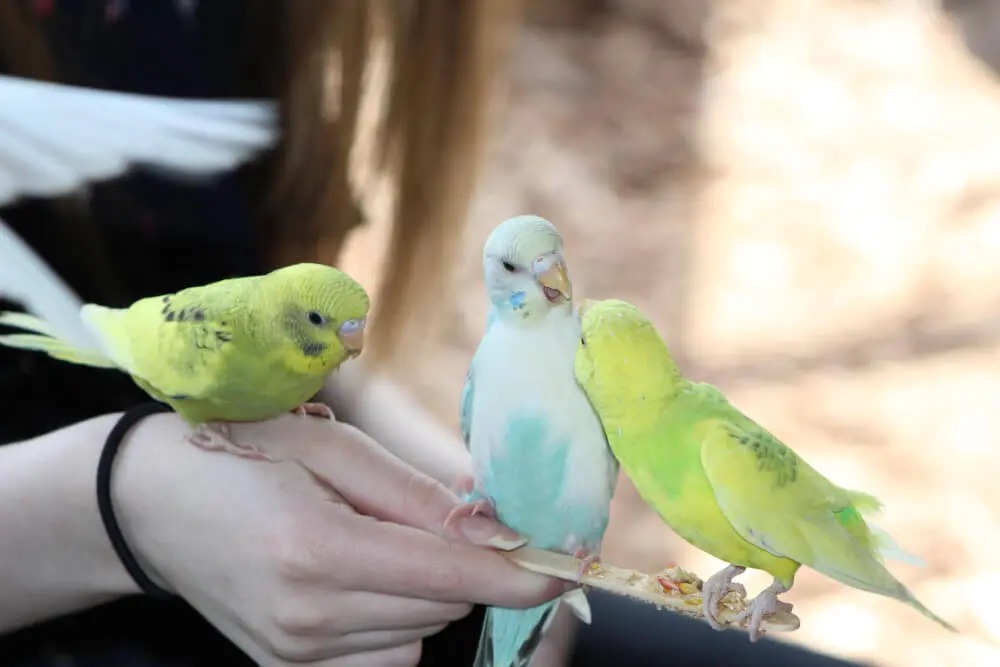Introduction to Budgerigar Behavior
Budgerigars, commonly known as budgies or parakeets, are fascinating and social birds that exhibit a variety of unique behaviors. Understanding budgerigar behavior is essential for anyone who owns or plans to own these delightful creatures. By learning about their habits and communication methods, you can ensure your budgie is happy, healthy, and well-adjusted.
Budgies are naturally curious and playful. They thrive in environments where they can explore and interact with their surroundings. One of the most notable aspects of budgie behavior is their social nature. These birds love to be around others, whether it’s their human caretakers or other budgies. Observing their social interactions can provide valuable insights into their needs and preferences.
Communication is another key element of budgerigar behavior. Budgies use a variety of sounds, from chirps and whistles to more complex vocalizations, to communicate with each other and their human companions. Understanding these sounds can help you better connect with your budgie and respond to their needs effectively.
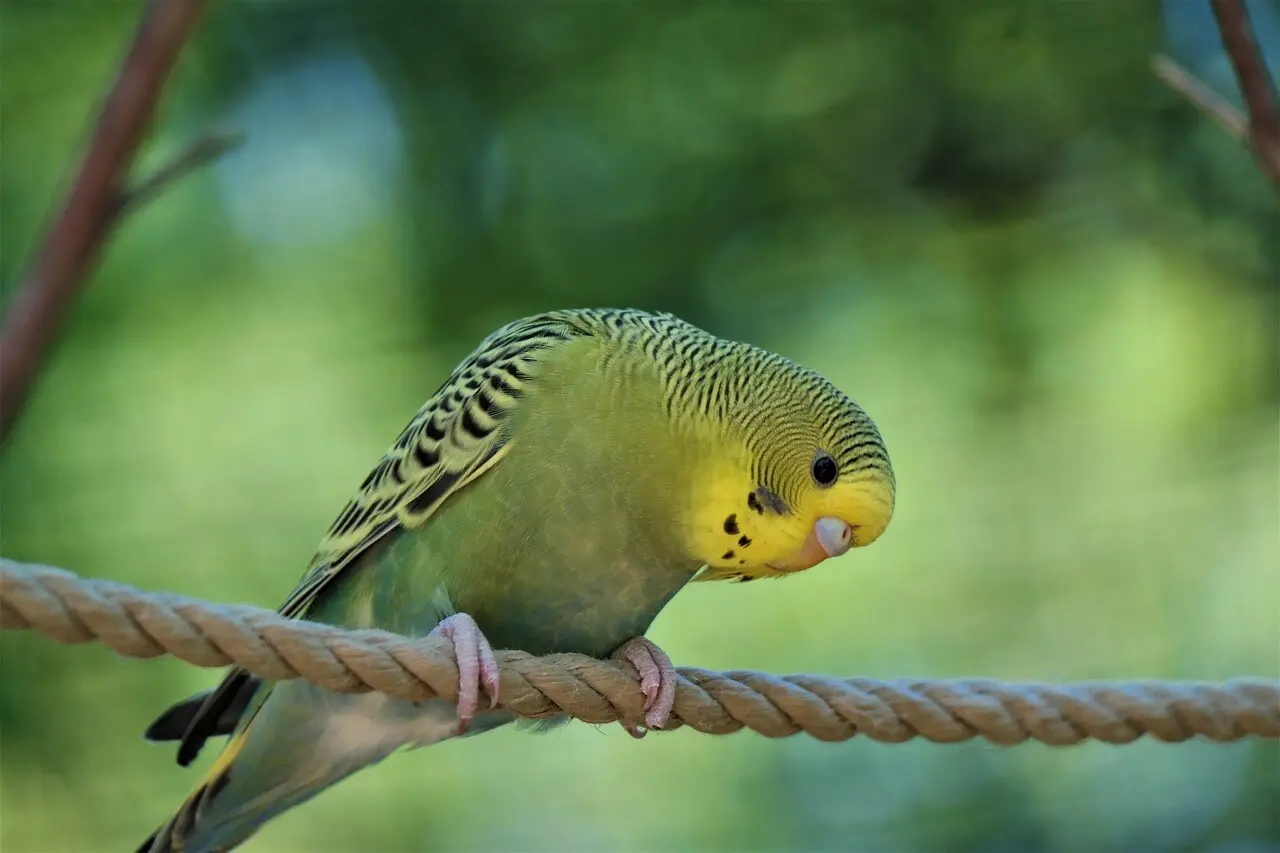
A curious budgerigar perches on a rope, tilting its head inquisitively.
Play and exercise are crucial for a budgie’s well-being. Regular playtime not only keeps them physically fit but also mentally stimulated. Providing a variety of toys and activities can prevent boredom and encourage natural behaviors, such as climbing, swinging, and foraging.
However, like all pets, budgies can sometimes exhibit behavioral issues. These might include excessive noise, aggression, or feather plucking. Identifying the root cause of these problems and addressing them promptly can help maintain a peaceful and happy home for both you and your budgie.
By paying attention to their behavior, you can also monitor your budgie’s health. Changes in their usual activity levels, eating habits, or vocalizations can be early signs of illness. Keeping a close eye on these indicators and seeking veterinary advice when necessary is vital for their health and longevity.
Creating an environment that caters to their behavioral needs is essential. Factors such as cage size, location, and enrichment activities all play a role in their overall well-being. A happy budgie is one that feels safe, engaged, and loved.
In summary, understanding budgerigar behavior is key to providing a fulfilling life for these charming birds. Whether it’s their social habits, communication methods, or playful antics, each aspect of their behavior offers a glimpse into their vibrant personalities. By nurturing these behaviors, you can build a strong bond with your budgie and enjoy the companionship of a truly remarkable pet.
Understanding Basic Budgerigar Behavior
Budgerigars, or budgies, have a range of behaviors that can tell you a lot about their mood, health, and overall well-being. Understanding these basic budgerigar behaviors is essential for creating a nurturing environment and building a strong bond with your feathered friend.
Vocalizations and Sounds
Budgies are very vocal birds. They use chirps, whistles, and even mimicry to communicate. If your budgie is chattering happily, it’s usually a sign of a content and healthy bird. Loud, persistent squawking can indicate distress or boredom. Learning to interpret these sounds helps you understand your budgie’s needs and emotions.
Body Language
Budgies express themselves through various body movements. For example, a budgie that is preening (cleaning its feathers) is comfortable and relaxed. Head bobbing can be a sign of excitement, while a fluffed-up appearance might indicate that your budgie is cold or not feeling well. Paying attention to these subtle cues is crucial for understanding your budgie’s behavior.
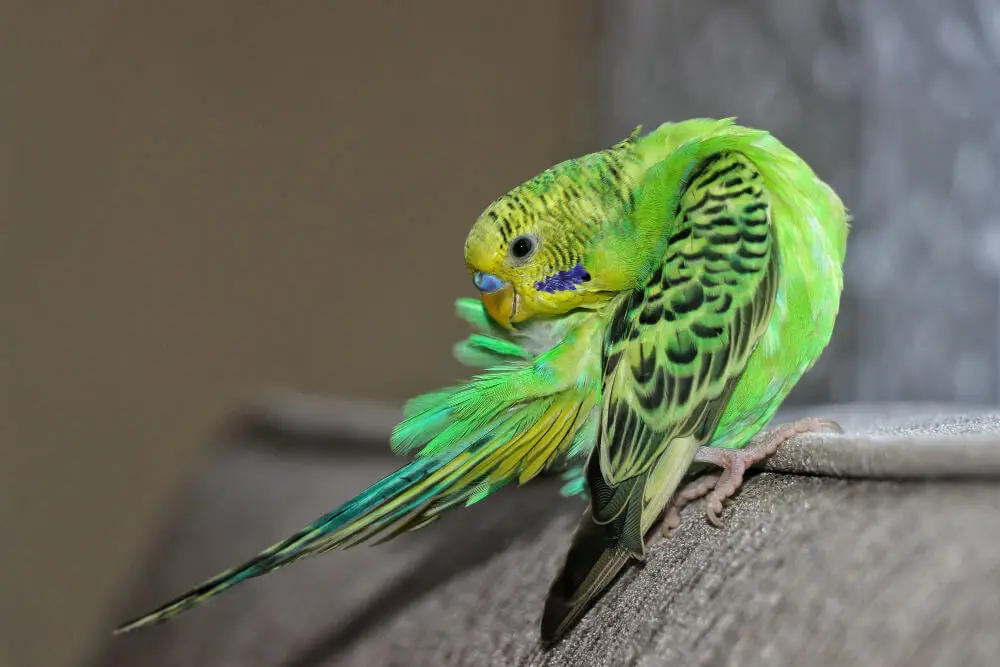
A budgerigar preening its feathers, showcasing self-grooming behavior.
Social Interaction
Budgies are highly social creatures. They enjoy the company of other budgies and thrive on interaction with their human caretakers. If you have more than one budgie, you’ll notice them engaging in mutual preening, which is a sign of bonding. Even a single budgie will seek attention and companionship from you, often enjoying head scratches and interactive play.
Play and Exercise
Play is an important part of a budgie’s life. They love to climb, swing, and chew on toys. Providing a variety of toys can keep them entertained and prevent boredom. Rotating toys regularly keeps things interesting and stimulates their natural curiosity. A happy budgie is one that gets plenty of play and exercise.
Feeding Habits
Observing your budgie’s eating habits can also provide insights into their behavior. Budgies enjoy a varied diet that includes seeds, fruits, and vegetables. A healthy appetite is a good sign, while a sudden decrease in food intake might signal health issues. Make sure to provide fresh food and clean water daily.
Sleeping Patterns
Budgies need about 10-12 hours of sleep each night. They usually sleep perched on one leg with their head tucked under a wing. A budgie that isn’t getting enough sleep may become irritable or lethargic. Ensuring they have a quiet, dark place to rest helps maintain their health and mood.
Signs of Affection
Budgies show affection in various ways. They might nuzzle your hand, give gentle pecks, or chirp softly when you’re near. These behaviors indicate that your budgie feels safe and bonded with you. Responding with gentle interaction and care strengthens this bond.
By understanding these basic budgerigar behaviors, you can better meet their needs and ensure they lead a happy, healthy life. Whether it’s through vocalizations, body language, or social interactions, each behavior offers a glimpse into your budgie’s world. Paying attention to these cues and responding appropriately helps create a nurturing and loving environment for your feathered friend.
Social Behavior of Budgerigars
Budgerigars, also known as budgies, are highly social birds that thrive on interaction and companionship. Understanding the social behavior of budgerigars is crucial for keeping them happy and healthy. Whether they’re interacting with other budgies or their human caretakers, these behaviors are key to their well-being.
Interaction with Other Budgies
Budgerigars are flock animals by nature. In the wild, they live in large groups, and this instinct carries over into domestic life. If you have more than one budgie, you’ll notice they engage in a variety of social behaviors. Mutual preening, where budgies clean each other’s feathers, is a sign of bonding and trust. You might also see them sharing food or toys, which indicates a strong social connection.
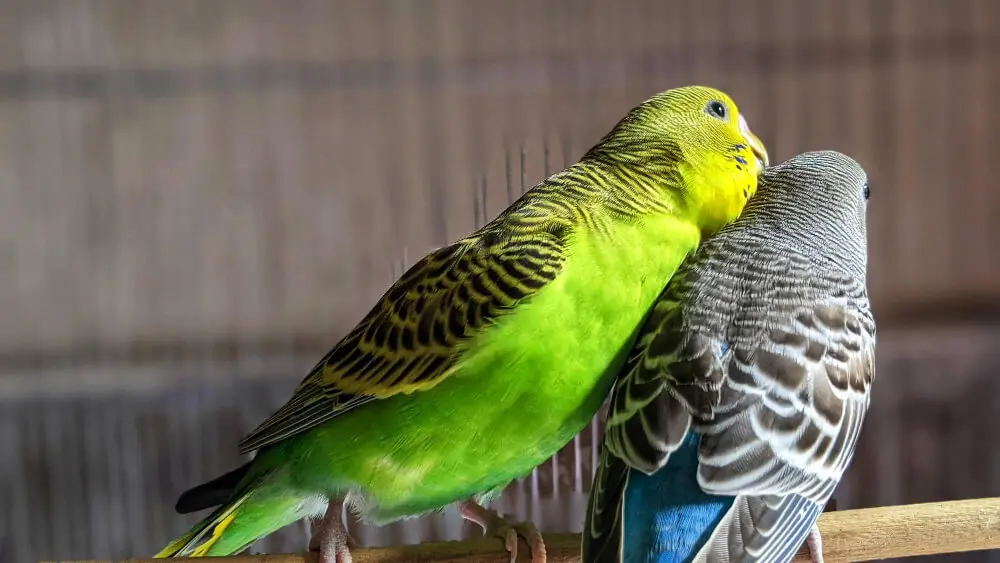
Two budgerigars cuddle on a perch, displaying affectionate behavior.
Hierarchical Structure
Within a group of budgies, a social hierarchy often forms. This pecking order helps maintain harmony and structure within the flock. Dominant budgies might take the lead during feeding times or claim the best perches. Understanding this hierarchy can help you manage multiple budgies and ensure a peaceful living environment.
Play and Interaction
Budgies love to play, and they often engage in interactive games with each other. You might see them chasing each other around the cage, swinging from toys, or playing tug-of-war with a piece of string. These playful interactions are not only fun to watch but also essential for their mental and physical stimulation.
Communication
Budgies communicate with each other through a range of vocalizations and body language. Chirping, singing, and mimicking sounds are all ways they express themselves and connect with others. Watching and listening to these interactions can give you insights into their social dynamics and individual personalities.
Bonding with Humans
Budgies also form strong bonds with their human caretakers. Spending time talking to your budgie, offering treats, and gently handling them can build trust and affection. Budgies show their fondness by chirping when you enter the room, nuzzling your hand, or perching on your shoulder. These behaviors indicate that your budgie sees you as a member of their flock.
Signs of Loneliness
A single budgie can become lonely without enough social interaction. Signs of loneliness include excessive chirping, feather plucking, or lethargy. To prevent this, make sure to spend plenty of time with your budgie each day. If possible, consider getting a second budgie to keep them company.
Introducing New Budgies
Introducing a new budgie to an existing one requires careful planning. Start by placing their cages next to each other so they can get used to each other’s presence. Gradually allow supervised interactions until they are comfortable together. Patience and careful observation are key to ensuring a smooth introduction.
Understanding the social behavior of budgerigars helps you create a nurturing environment that meets their need for companionship and interaction. Whether through bonding with other budgies or with you, their human companion, these social behaviors are essential for a happy, healthy life. By paying attention to their social cues and providing ample opportunities for interaction, you can ensure your budgie thrives in your care.
Communication Methods in Budgerigars
Budgerigars, often called budgies, are known for their vibrant and expressive communication methods. Understanding these communication methods in budgerigars can help you better connect with your feathered friend and ensure their needs are met.
Vocalizations
Budgerigars are highly vocal birds that use a variety of sounds to communicate. Their vocalizations range from simple chirps and whistles to complex mimicry of sounds they hear in their environment.
- Chirping and Singing: Happy and content budgies often chirp and sing. These sounds can indicate that they are relaxed and enjoying their surroundings.
- Mimicry: Budgies are excellent mimics and can learn to replicate sounds and even words they hear frequently. This mimicry is a sign of their intelligence and desire to interact.
- Squawking: Loud, repetitive squawking can indicate distress, boredom, or a desire for attention. It’s important to understand the context to address their needs properly.
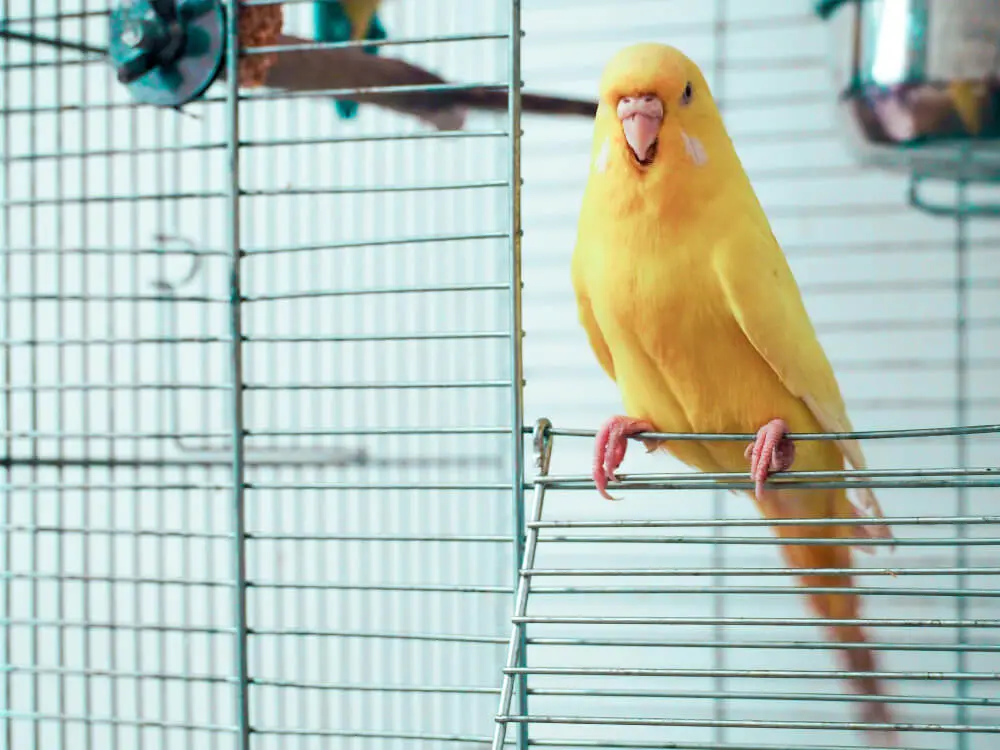
A yellow budgerigar sings inside its cage, filling the air with melodious tunes.
Body Language
Budgerigars use body language extensively to convey their feelings and intentions. Observing these physical cues can provide valuable insights into their mood and well-being.
- Feather Posture: Fluffed-up feathers can indicate that a budgie is cold or not feeling well, while sleek feathers usually mean they are relaxed.
- Head Bobbing: This behavior often signifies excitement or a desire for attention. It’s common during play or when they are trying to interact with you.
- Wing Stretching: Stretching one wing and one leg is a normal behavior that shows they are comfortable and relaxed.
Eye Movements
Budgies also communicate through their eyes. Understanding these subtle cues can help you gauge their emotional state.
- Pupil Dilation: Rapid changes in pupil size can indicate excitement or agitation. If their pupils are pinning (rapidly changing size), they might be highly stimulated or nervous.
- Soft Gaze: A relaxed budgie will have a soft, steady gaze, showing they feel safe and comfortable.
Social Interactions
Budgerigars are social animals and their interactions with each other can tell you a lot about their communication methods.
- Mutual Preening: When budgies preen each other, it’s a sign of trust and affection. This behavior strengthens social bonds and shows that they are comfortable with one another.
- Beak Touching: Budgies often touch beaks as a friendly gesture, similar to a handshake in humans. It’s a way of showing familiarity and friendship.
Interaction with Humans
Budgies also communicate directly with their human caretakers. Paying attention to these signals can enhance your bond with them.
- Nuzzling and Pecking: Gentle nuzzling or pecking at your hand is a sign of affection. It means your budgie trusts you and enjoys your company.
- Vocal Mimicry: When a budgie mimics words or sounds you make, it’s their way of engaging with you. Responding positively can encourage more interaction.
Environmental Signals
Budgies respond to changes in their environment, and these responses can be a form of communication.
- Alarm Calls: Sudden, loud noises can trigger alarm calls in budgies. Understanding these calls helps you ensure their environment is safe and secure.
- Quietness: If your usually vocal budgie becomes unusually quiet, it might be a sign of discomfort or illness. Monitoring their behavior can help you catch any issues early.
By understanding the communication methods in budgerigars, you can create a more interactive and fulfilling relationship with your pet. Their vocalizations, body language, and social interactions all provide valuable insights into their needs and emotions. Responding to these cues with care and attention helps ensure a happy, healthy life for your budgie.
Budgerigar Play and Exercise Habits
Budgerigars, or budgies, are lively and active birds that thrive on play and exercise. Understanding budgerigar play and exercise habits is key to ensuring they lead a happy, healthy life. Providing ample opportunities for physical activity and mental stimulation keeps them engaged and content.
Importance of Play
Play is essential for budgerigars as it helps them stay physically fit and mentally stimulated. Budgies have a natural curiosity and love to explore their environment. Playtime allows them to express these instincts, keeping them entertained and preventing boredom.
Types of Toys
Budgies enjoy a variety of toys that cater to their different needs:
- Chew Toys: Budgies love to chew, and providing safe, bird-friendly chew toys helps satisfy this instinct. These toys also keep their beaks healthy.
- Swings and Ladders: Budgies enjoy climbing and swinging. Installing swings and ladders in their cage encourages physical activity and provides endless entertainment.
- Foraging Toys: These toys challenge budgies to find hidden treats, stimulating their minds and keeping them engaged for hours.
- Mirrors: Budgies are fascinated by their reflections and often interact with mirrors as if they were another bird. However, it’s important to balance mirror use with other types of toys to prevent over-reliance.
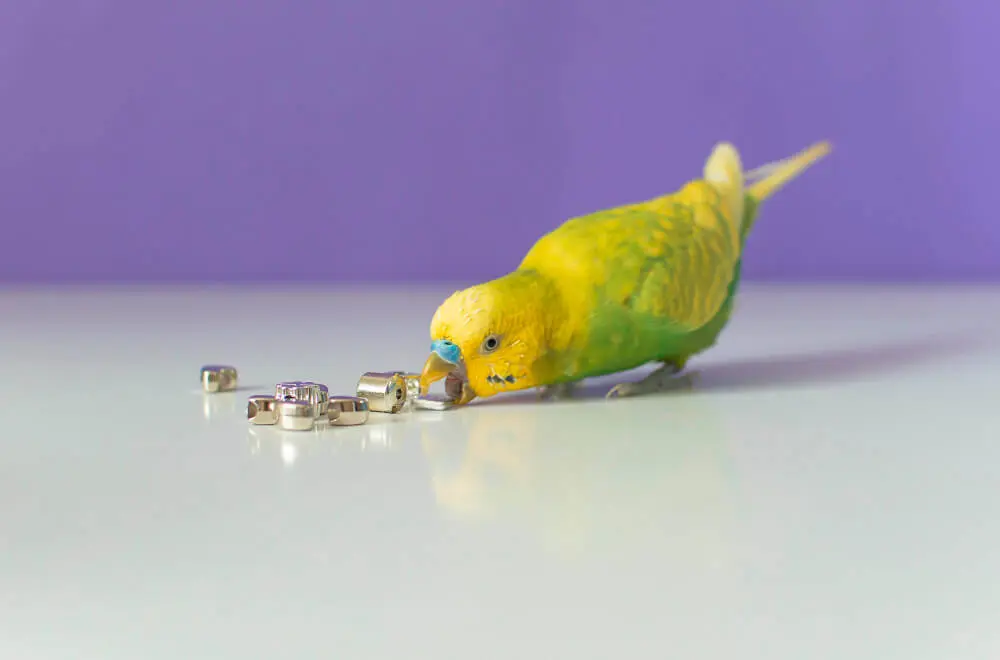
A playful budgerigar interacts with a toy bead, demonstrating its curious nature.
Exercise Routines
Regular exercise is crucial for a budgie’s health. Here are some ways to ensure they get enough exercise:
- Flight Time: Allowing your budgie to fly in a safe, enclosed space is one of the best ways to provide exercise. Flight helps build strong muscles and keeps them agile.
- Interactive Play: Spend time each day engaging with your budgie. Use interactive toys or simply let them perch on your hand or shoulder while you move around.
- Cage Layout: Arrange the cage to encourage movement. Place perches, swings, and toys at different heights and locations to promote climbing and flying within the cage.
Social Play
Budgies are social creatures and enjoy playing with each other. If you have more than one budgie, you’ll notice them engaging in games like chase or tug-of-war with toys. These interactions are not only fun but also strengthen their social bonds.
Signs of Enjoyment
Recognizing the signs that your budgie is enjoying playtime is important. Happy budgies will chirp, sing, and engage actively with their toys. They might also display behaviors like head bobbing and wing flapping, indicating excitement and joy.
Preventing Boredom
Boredom can lead to negative behaviors such as feather plucking or excessive squawking. To prevent this, rotate toys regularly to keep things fresh and interesting. Introduce new toys periodically and rearrange the cage layout to provide new challenges and experiences.
Safe Play Environment
Ensure that the play environment is safe for your budgie. Remove any hazards such as sharp objects, toxic plants, or open water sources. Supervise their playtime outside the cage to prevent accidents and keep them out of harm’s way.
Enrichment Activities
In addition to toys, enrichment activities can enhance your budgie’s play and exercise routine. These can include:
- Training Sessions: Teach your budgie simple tricks like stepping up onto your finger or flying to you on command. Training is mentally stimulating and strengthens your bond.
- Music and Sounds: Budgies enjoy music and will often chirp along to tunes. Play different types of music to see what your budgie prefers.
- Outdoor Time: If safe and feasible, provide supervised outdoor time in a secure aviary. The fresh air and natural environment offer new sights and sounds to explore.
Understanding budgerigar play and exercise habits helps you provide a stimulating and fulfilling environment for your pet. By incorporating a variety of toys, activities, and interactions, you can ensure your budgie stays happy, healthy, and engaged. Regular play and exercise not only improve their physical health but also their mental well-being, leading to a more vibrant and joyful life.
Common Behavioral Issues and Solutions
Budgerigars, or budgies, are generally friendly and playful birds, but they can sometimes exhibit behavioral issues. Understanding these common behavioral issues and solutions is crucial for maintaining a happy and healthy relationship with your pet.
Excessive Squawking
Budgerigars are naturally vocal, but excessive squawking can be a sign of distress, boredom, or a need for attention.
Solution:
- Ensure your budgie’s cage is in a quiet but interactive part of your home.
- Provide a variety of toys and rotate them regularly to keep your budgie entertained.
- Spend quality time interacting with your budgie each day to prevent loneliness.
Feather Plucking
Feather plucking can be a sign of stress, boredom, or underlying health issues. It’s important to address this behavior promptly.
Solution:
- Ensure your budgie has a stimulating environment with plenty of toys and activities.
- Check for any potential sources of stress, such as loud noises or other pets.
- Consult a veterinarian to rule out any medical conditions.
Aggression
Aggression can occur if a budgie feels threatened or territorial. This behavior might manifest as biting or lunging at humans or other budgies.
Solution:
- Identify and remove any triggers for aggression, such as overcrowded cages or lack of resources.
- Provide separate spaces or additional perches and feeding stations if you have multiple budgies.
- Spend time handling and socializing your budgie to build trust and reduce fear.
Biting
Budgies may bite due to fear, stress, or a lack of socialization. Understanding the cause of biting is key to addressing it effectively.
Solution:
- Handle your budgie gently and frequently to build trust.
- Avoid sudden movements or loud noises that might startle your budgie.
- Offer treats and positive reinforcement to create a positive association with handling.

A budgerigar bites a person’s finger, indicating possible aggressive behavior.
Pacing and Repetitive Movements
Pacing or repetitive movements in budgerigars can indicate boredom, anxiety, or an unsuitable cage environment.
Solution:
- Ensure your budgie’s cage is spacious enough to allow for natural movement.
- Provide a variety of toys and rearrange the cage layout regularly to keep things interesting.
- Allow for regular out-of-cage time in a safe environment to provide mental and physical stimulation.
Refusal to Eat
A budgie refusing to eat can be a sign of illness, stress, or a dislike for a particular type of food.
Solution:
- Offer a variety of foods, including seeds, fruits, and vegetables, to find what your budgie prefers.
- Ensure the food and water dishes are clean and accessible.
- Consult a veterinarian if the refusal to eat persists, as it could indicate an underlying health issue.
Fearfulness
Budgies can become fearful due to a lack of socialization or negative past experiences.
Solution:
- Spend time near your budgie’s cage, speaking softly to help them get used to your presence.
- Gradually introduce handling by offering treats and allowing your budgie to approach you at their own pace.
- Create a calm and stable environment to reduce stress and fear.
Inactivity
Inactivity or lethargy in budgerigars can be a sign of boredom or health issues.
Solution:
- Ensure your budgie has plenty of toys and opportunities for exercise.
- Encourage play and interaction to stimulate both mental and physical activity.
- Monitor your budgie’s health and consult a veterinarian if inactivity continues.
Understanding common behavioral issues and solutions in budgerigars helps create a nurturing environment for your pet. By recognizing the signs of distress and addressing them promptly, you can ensure your budgie leads a happy, healthy life. Regular interaction, a stimulating environment, and proper care are key to preventing and resolving these behavioral issues, allowing you to enjoy a harmonious relationship with your feathered friend.
Training and Enrichment for Budgerigars
Training and enrichment are essential for keeping budgerigars, or budgies, happy, healthy, and mentally stimulated. By understanding the basics of training and providing enriching activities, you can enhance your budgie’s quality of life and strengthen your bond with them.
Why Training is Important
Training your budgerigar helps build trust, improve behavior, and provide mental stimulation. It also makes handling easier and more enjoyable for both you and your bird. Training sessions should be short, fun, and rewarding to keep your budgie engaged.
Basic Training Tips
Start with the Basics: Begin with simple commands like “step up” and “step down.” Use a perch or your finger and gently encourage your budgie to step onto it. Reward them with a treat and praise.
Use Positive Reinforcement: Always reward good behavior with treats, praise, or gentle petting. Positive reinforcement helps your budgie associate training with positive outcomes.
Be Patient and Consistent: Training takes time and consistency. Practice daily but keep sessions short, around 5-10 minutes, to prevent your budgie from becoming overwhelmed.
Create a Calm Environment: Ensure the training area is quiet and free from distractions. This helps your budgie focus on the training session.
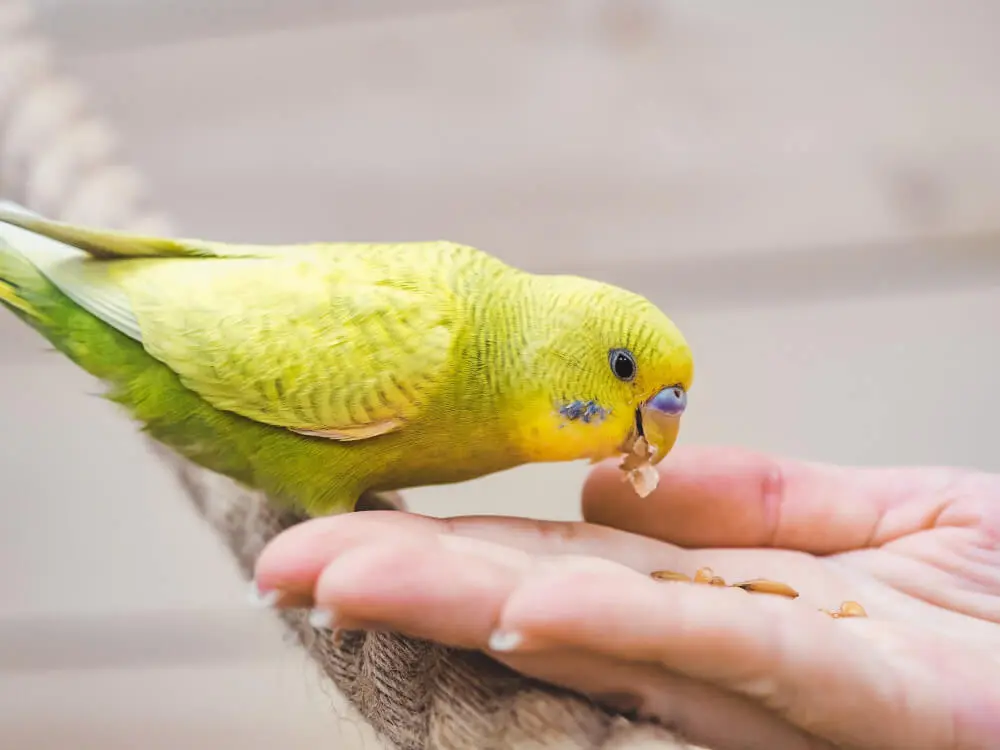
A budgerigar eats from a person’s hand, showing successful training and trust.
Advanced Training Techniques
Teaching Tricks: Once your budgie masters the basics, you can teach them fun tricks like waving, turning around, or fetching small objects. Break down each trick into small steps and reward progress.
Target Training: Use a small stick or target and teach your budgie to follow it. This technique can help with more complex behaviors and improve their focus.
Recall Training: Train your budgie to come to you when called. Start by calling them from a short distance and gradually increase the distance as they become more confident.
Enrichment Activities
Providing enrichment activities is crucial for your budgie’s mental and physical well-being. Here are some ideas to keep them engaged:
Interactive Toys: Offer a variety of toys that encourage climbing, chewing, and exploring. Rotate toys regularly to keep your budgie interested.
Foraging Activities: Hide treats in foraging toys or around the cage to encourage your budgie to search for their food. This mimics natural behaviors and provides mental stimulation.
Playtime Outside the Cage: Allow your budgie to explore a safe, bird-proofed room. Supervised out-of-cage time provides exercise and a change of scenery.
Social Interaction: Spend quality time with your budgie each day. Talk to them, offer head scratches, and involve them in your daily activities to keep them socially stimulated.
Environmental Enrichment: Rearrange the cage layout, add new perches, and introduce natural elements like branches or leaves. A varied environment prevents boredom and encourages exploration.
Benefits of Enrichment
Enrichment activities help prevent behavioral issues such as feather plucking, excessive squawking, and aggression. They also improve your budgie’s overall health and happiness by providing necessary mental and physical challenges.
Monitoring Your Budgie’s Response
Pay attention to how your budgie responds to training and enrichment activities. Every budgie is unique, so adjust your approach based on their preferences and comfort levels. If your budgie seems stressed or uninterested, try different activities or techniques.
Training and enrichment for budgerigars are vital for their well-being. By incorporating these practices into your budgie’s daily routine, you can ensure they remain happy, healthy, and engaged. Regular training sessions, a variety of toys, and interactive activities will not only enhance your budgie’s life but also strengthen the bond you share. A well-trained and enriched budgie is a joyful companion, bringing endless delight to your home.
Health Indicators in Budgerigar Behavior
Understanding the health indicators in budgerigar behavior is crucial for ensuring your budgie stays happy and healthy. Budgerigars, or budgies, often show signs of their physical and mental well-being through their behavior. Recognizing these signs early can help you address potential health issues promptly.
Vocalizations and Sounds
A healthy budgie is typically vocal and active. Happy budgies will chirp, sing, and mimic sounds.
Normal Vocalizations: Regular chirping and singing indicate that your budgie is content and engaged with its environment. Changes in Vocalization: A sudden decrease in vocalizations can be a sign of illness or distress. Conversely, excessive squawking might indicate discomfort or boredom.
Activity Levels
Budgies are naturally active birds. Observing their activity levels can provide insights into their health.
Active and Playful: A healthy budgie will spend a good part of the day playing, exploring, and interacting with its surroundings. Lethargy: If your budgie is unusually inactive, sitting still for long periods, or sleeping more than usual, it might be a sign of illness.
Eating and Drinking Habits
Monitoring your budgie’s eating and drinking habits is vital.
Healthy Appetite: A budgie with a healthy appetite will eat regularly and show interest in its food. Changes in Appetite: A decrease in food intake or a lack of interest in food can indicate health problems. Ensure your budgie is drinking enough water, as dehydration can quickly become serious.

A group of budgerigars gathers around a feeder, enjoying a healthy meal together.
Feather Condition
Feathers are a good indicator of your budgie’s health.
Smooth and Bright Feathers: Healthy budgies have smooth, bright feathers that they regularly preen to keep clean. Ruffled or Dull Feathers: Feathers that appear ruffled, dull, or are being plucked out can indicate stress, illness, or nutritional deficiencies.
Droppings
The condition of your budgie’s droppings can provide clues about its health.
Normal Droppings: Healthy budgie droppings are firm with a white part (urates) and a darker part (feces). Abnormal Droppings: Watery, discolored, or very loose droppings can indicate digestive issues or infections.
Breathing
Budgies should breathe quietly and without effort.
Normal Breathing: Quiet, steady breathing is a sign of good health. Labored Breathing: If your budgie is breathing heavily, making wheezing sounds, or bobbing its tail while breathing, it could be a sign of respiratory issues.
Behavior and Mood
Your budgie’s overall behavior and mood are also important health indicators.
Alert and Curious: A healthy budgie is alert, curious, and responsive to its environment and interactions. Withdrawn or Aggressive: Changes in behavior, such as becoming withdrawn, aggressive, or unusually quiet, can signal health issues or distress.
Weight
Regularly monitoring your budgie’s weight can help you detect health problems early.
Consistent Weight: Maintaining a consistent weight is a good indicator of health. Weight Loss or Gain: Unexplained weight loss or gain can be a sign of underlying health issues and should be checked by a vet.
Eyes and Beak
The condition of your budgie’s eyes and beak can also indicate health status.
Bright Eyes and Clean Beak: Healthy budgies have bright, clear eyes and a clean, smooth beak. Discharge or Swelling: Any discharge from the eyes or nostrils, or swelling around the beak, requires veterinary attention.
By understanding the health indicators in budgerigar behavior, you can ensure your budgie remains healthy and happy. Regularly observing their vocalizations, activity levels, eating habits, feather condition, droppings, breathing, behavior, weight, and the condition of their eyes and beak will help you catch any potential health issues early. Providing a nurturing environment, a balanced diet, and regular veterinary check-ups are essential for maintaining your budgie’s well-being. A healthy budgie is an active, vocal, and content companion, bringing joy and liveliness to your home.
Environmental Factors Influencing Budgerigar Behavior
The environment in which your budgerigar lives plays a significant role in shaping its behavior and overall well-being. Understanding the environmental factors influencing budgerigar behavior can help you create a comfortable, stimulating, and healthy habitat for your feathered friend.
Cage Size and Layout
The size and layout of your budgie’s cage are crucial for its comfort and activity levels.
Adequate Space: Budgies need a spacious cage to move around, stretch their wings, and play. A cramped cage can lead to stress and behavioral issues. Varied Layout: Arrange perches, toys, and food dishes in a way that encourages movement and exploration. Include different levels to promote climbing and flying within the cage.
Perches and Toys
Perches and toys are essential for keeping your budgie active and mentally stimulated.
Variety of Perches: Use a mix of perches made from different materials and of various diameters to keep your budgie’s feet healthy and prevent boredom. Engaging Toys: Provide a variety of toys, such as swings, ladders, and chew toys, to keep your budgie entertained. Rotate toys regularly to maintain interest.
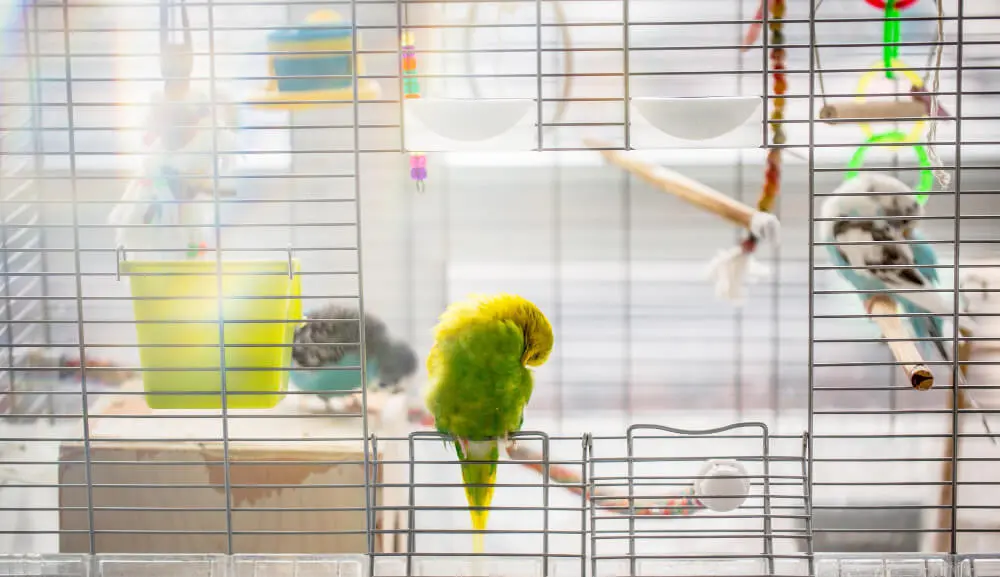
A budgerigar preens itself inside a well-arranged cage, maintaining its plumage.
Lighting and Day-Night Cycle
Proper lighting and a consistent day-night cycle are vital for your budgie’s health.
Natural Light: Place the cage in a location that receives natural light, but avoid direct sunlight which can overheat the cage. Consistent Schedule: Maintain a regular day-night cycle by covering the cage at night to provide darkness and uncovering it in the morning. This helps regulate your budgie’s sleep patterns and overall well-being.
Temperature and Humidity
Budgies are sensitive to temperature and humidity changes.
Stable Temperature: Keep the cage in a room with a stable temperature, ideally between 65-85°F (18-29°C). Avoid placing the cage near drafts, air conditioners, or heaters. Humidity Levels: Maintain moderate humidity levels to prevent respiratory issues. Use a humidifier if the air in your home is very dry.
Noise and Activity Levels
The amount of noise and activity in the environment affects your budgie’s behavior.
Calm Environment: Place the cage in a quiet part of your home, away from loud noises and high traffic areas. Sudden loud noises can startle your budgie and cause stress. Interaction Opportunities: Ensure your budgie has opportunities for social interaction. Talk to them, play with them, and consider placing the cage where they can observe household activities without being overwhelmed.
Cleanliness and Hygiene
A clean environment is essential for preventing illness and promoting healthy behavior.
Regular Cleaning: Clean the cage, perches, and toys regularly to prevent the build-up of bacteria and mold. Fresh Food and Water: Provide fresh food and clean water daily. Remove any uneaten food to prevent spoilage and contamination.
Social Interaction
Budgies are social birds and need regular interaction to stay happy.
Time with Owners: Spend time interacting with your budgie each day. Talk to them, offer head scratches, and involve them in your daily activities. Companion Budgie: If possible, consider getting a second budgie to provide companionship. Budgies often thrive with a buddy to interact with.
Environmental Enrichment
Enriching your budgie’s environment helps keep them mentally and physically stimulated.
Foraging Opportunities: Hide treats in foraging toys or around the cage to encourage natural foraging behavior. Natural Elements: Include natural elements like branches, leaves, and safe plants to create a more interesting and engaging environment.
Stress Reduction
Reducing stress in your budgie’s environment is key to promoting positive behavior.
Avoid Sudden Changes: Make any changes to the cage or environment gradually to avoid stressing your budgie. Safe Space: Ensure your budgie has a safe space within the cage where they can retreat and feel secure.
Environmental factors play a crucial role in influencing budgerigar behavior. By providing a spacious and well-arranged cage, a consistent day-night cycle, stable temperature, and opportunities for social interaction and enrichment, you can create a nurturing environment for your budgie. Paying attention to these factors helps ensure your budgie remains happy, healthy, and well-behaved, enriching both their life and yours.
Conclusion: Encouraging Positive Budgerigar Behavior
Encouraging positive budgerigar behavior is key to ensuring your feathered friend leads a happy and healthy life. By understanding their needs and creating a supportive environment, you can foster a strong bond and promote well-being.
Building Trust and Bonding
The foundation of positive behavior in budgerigars is trust. Spend quality time with your budgie daily. Talk to them gently, offer treats, and handle them with care. Consistent, positive interactions build trust and make your budgie feel secure.
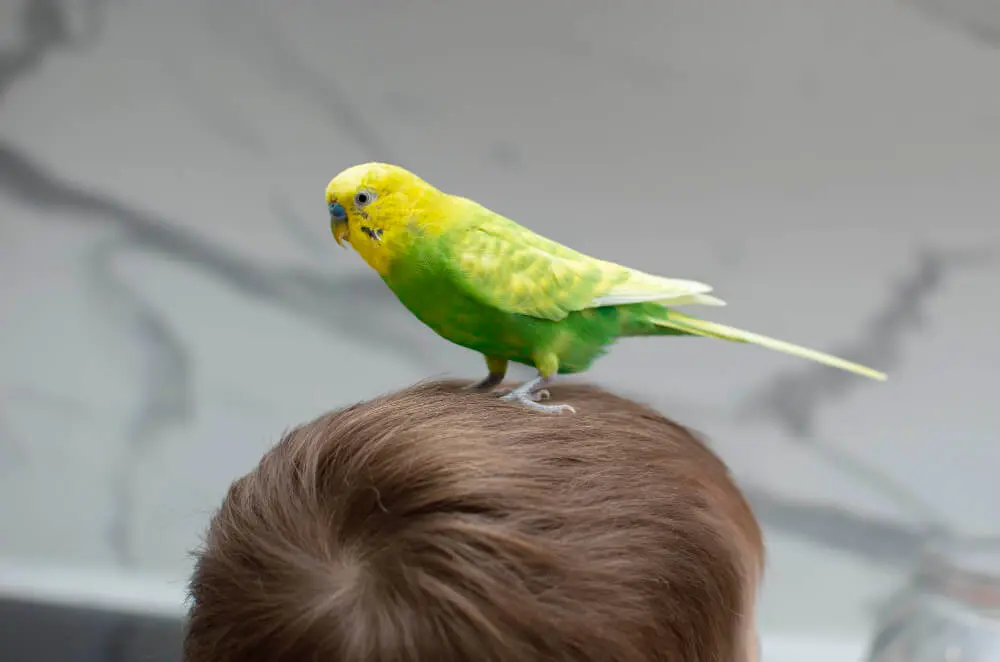
A budgerigar perches on a child’s head, showing playful and trusting behavior.
Providing a Stimulating Environment
A stimulating environment is essential for a happy budgie. Ensure their cage is spacious and filled with a variety of toys, perches, and foraging opportunities. Rotate toys regularly to keep your budgie engaged and curious. An enriched environment prevents boredom and promotes natural behaviors.
Regular Training and Interaction
Training is an excellent way to encourage positive behavior. Start with simple commands like “step up” and gradually introduce more complex tricks. Use positive reinforcement with treats and praise to make training sessions enjoyable. Regular interaction and training sessions strengthen your bond and keep your budgie mentally stimulated.
Ensuring Social Interaction
Budgies are social creatures that thrive on interaction. Spend time interacting with your budgie each day. If possible, consider getting a second budgie for companionship. Social interaction helps prevent loneliness and behavioral issues.
Maintaining Health and Hygiene
Good health is the cornerstone of positive behavior. Provide a balanced diet, fresh water, and regular veterinary check-ups. Keep the cage clean to prevent illness. Monitor your budgie’s health indicators and address any changes promptly.
Consistent Routine and Environment
Budgerigars thrive in a consistent routine. Maintain a regular day-night cycle, feed them at consistent times, and ensure their environment is stable. Avoid sudden changes that could cause stress. A predictable routine helps your budgie feel safe and secure.
Addressing Behavioral Issues Promptly
Pay attention to any changes in your budgie’s behavior. Address issues like excessive squawking, feather plucking, or aggression promptly. Identify the root cause, whether it’s boredom, stress, or a health problem, and take appropriate action. Early intervention prevents problems from becoming ingrained habits.
Providing Opportunities for Exercise
Regular exercise is vital for a healthy budgie. Allow your budgie out-of-cage time in a safe, supervised space. Encourage flying, climbing, and playing. Exercise keeps your budgie physically fit and mentally alert.
Positive Reinforcement
Always use positive reinforcement to encourage good behavior. Reward your budgie with treats, praise, and attention when they exhibit desired behaviors. Positive reinforcement strengthens the bond between you and your budgie and promotes a happy, well-behaved pet.
Encouraging positive budgerigar behavior involves a combination of trust-building, environmental enrichment, regular interaction, and attention to health and routine. By understanding and meeting your budgie’s needs, you can foster a joyful, engaging relationship. A happy, healthy budgie is a delightful companion, bringing joy and vibrancy to your home. Take the time to nurture and understand your budgie, and you will be rewarded with a loving and well-behaved pet.
Frequently Asked Questions about Budgerigar Behavior
Understanding budgerigar behavior can sometimes be challenging for new bird owners. Here are some frequently asked questions to help you better understand and care for your budgie.
Why does my budgie chirp so much?
Budgies are naturally vocal birds and chirping is a normal part of their behavior. Chirping can indicate happiness, excitement, or a desire to communicate. If your budgie is chirping excessively, it could be seeking attention or responding to environmental stimuli. Providing toys, social interaction, and a stimulating environment can help manage their vocalizations.
What does it mean when my budgie fluffs up its feathers?
Fluffed-up feathers can indicate different things depending on the context. A budgie may fluff up its feathers when it’s cold, to retain heat, or when it’s feeling relaxed and comfortable. However, if your budgie is consistently fluffed up and appears lethargic, it might be a sign of illness. Monitoring other behaviors and consulting a vet if necessary is important.
Why is my budgie biting me?
Budgies may bite for several reasons, including fear, stress, or territorial behavior. To reduce biting, ensure your budgie feels safe and secure. Avoid sudden movements and loud noises. Gradually build trust through gentle handling and positive reinforcement. If biting persists, observe for potential stressors or health issues.
How can I tell if my budgie is happy?
A happy budgie is active, vocal, and curious. Signs of a content budgie include regular chirping, singing, playing with toys, and interacting with you. Healthy preening and a smooth, bright feather appearance are also indicators of a happy budgie. Providing a stimulating environment and regular social interaction helps maintain their happiness.
Why does my budgie pace back and forth?
Pacing can be a sign of boredom, stress, or a desire for more interaction. Ensure your budgie has a variety of toys and opportunities for mental stimulation. Spending more time with your budgie and allowing out-of-cage time can help reduce pacing behavior. Reassessing their environment to make it more engaging can also help.
What should I do if my budgie is not eating?
If your budgie suddenly stops eating, it could be a sign of illness or stress. Ensure that their food and water are fresh and accessible. Offer a variety of foods, including their favourites, to stimulate appetite. If the lack of eating persists, consult a vet to rule out any underlying health issues.
How can I stop my budgie from squawking loudly?
Excessive squawking can be due to boredom, loneliness, or a need for attention. Provide plenty of toys and activities to keep your budgie entertained. Ensure they have social interaction with you and possibly another budgie. Establishing a consistent daily routine can also help reduce excessive vocalizations.
What does it mean when my budgie bobs its head?
Head bobbing is a common budgie behavior that usually indicates excitement or a desire for attention. Budgies often bob their heads when they are happy, playing, or trying to interact with you. It’s a positive sign of engagement and enjoyment.
Why is my budgie plucking its feathers?
Feather plucking can be a sign of stress, boredom, or health issues. Ensure your budgie has a stimulating environment with plenty of toys and activities. Regular interaction and socialization can reduce stress. If feather plucking continues, consult a vet to rule out any medical conditions and receive advice on managing this behavior.
How can I encourage my budgie to play with toys?
Introduce new toys gradually and place them in different parts of the cage to stimulate curiosity. Rotate toys regularly to maintain interest. Spend time showing your budgie how to play with the toys by interacting with them yourself. Positive reinforcement with treats and praise can also encourage your budgie to engage with toys.
By understanding and addressing these common questions about budgerigar behavior, you can create a nurturing and supportive environment for your pet. Regular observation, interaction, and providing a stimulating habitat are key to ensuring your budgie remains happy, healthy, and well-behaved.

